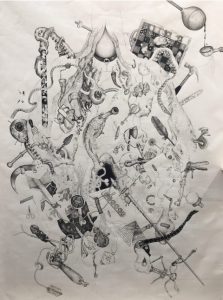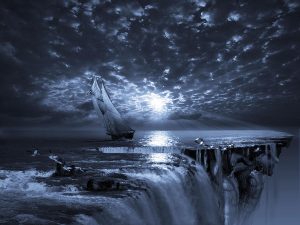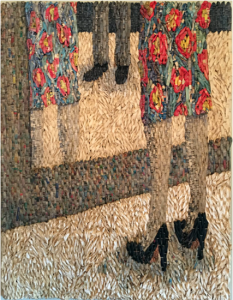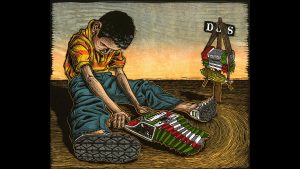Niveditha Ajay
Neo-Surrealism is often defined as the rejuvenation of the Surrealist movement, rising during the late 20th century. The complete transformation of society caused by the growth of digital technology is regarded by many as the cause and like many waves in the history of art, it is too vast and fragmented to be considered a movement. It is closely related to the Surrealist movement- which was itself a response to the rapid changes of the early 20th century. Characterised by its fascination with the absurd and the bizarre, the Surrealist movement forms the base to understand Neo- Surrealism, which now deals with an array of mediums and styles- from the psychedelic to digital art and even 3D modelling. The rise of Neo- Surrealism, critics argue, has prevented determining the end of the Surrealist movement, with debates on whether Neo-Surrealism is simply a rejuvenation or a style of its own. While it has grown into a unique entity, the core ideals of the original movement are still reflected in the works of the Neo- Surrealists.

Credit: aichasnoussi
Originating in Europe between the late 1910s and early 1920s, the Surrealist movement was a cultural phenomenon that began with literature. Surrealist writing was heavily influenced by the ideas of what lay beyond the construction of the “real”. The concept was to employ the inner workings of the mind, to discover what could be literature and later, art, if not restricted by the socially accepted norms of form and structure. Surrealism, hence, produced writing and visuals that question the physical, proportion, reality, and perception- the result allowing for the illogical, and unification between dreams and reality.
A primary contributor to institutionalising the movement is Andre Breton with his work “The Surrealist Manifesto” of 1924. Breton’s vision of the movement included the formation of an “absolute reality”- formed when the contradiction between reality and dreams is resolved. His work, along with the larger organised movement was heavily inspired by the concepts of Psychoanalysis and Dream Interpretation as given by Sigmund Freud. The exploration of the unconscious formed an essential part of Surrealist writing and art. Additionally, Karl Marx’s Communist Movement, too, was a great influence.
Early influences of Surrealist art were the visual artists Georgio De Chirico, Pablo Picasso and Duchamp. These works portrayed objects, shapes and images that were not restricted to their assigned habitats- eliciting curiosity and juxtaposed readings. Some of them were also erotic in nature, a feature that later carried on to the Surrealists. The first visual artists who began working with Surrealist imagery were Max Ernst, Andre Masson, Man Ray and Joan Miro. The works of these artists explored the deeply personal subconscious to produce work that portrayed bizarre and non-sensical imagery, that cannot be completely understood by a viewer but simply empathised with.
Rene Magritte, a Belgian artist was especially significant in building the vision of Surrealist art. His works are shocking, confusing and elicits contemplation. The Eternally Obvious (1930), one of his most popular pieces, presents a dismembered female nude- subverting the ideals of image relating to the female body. Salvador Dali, one of the most well-known participants of the movement expanded on the visions of Magritte to create brilliant pieces of art now well known for their exploration of the surreal, hallucinogenic dreamscapes of the unconscious often accompanied by sexually charged imagery as seen in The Accommodations of Desire.

Credit: Pixels
The Second World War caused the displacement and eventual disintegration of the Surrealist movement. A brief revival of the movement after the war led to the inclusion of artists from Latin America such as Frida Kahlo among others- though they never joined the movement formally. New branches such as Magical Realism developed, and the earlier movement fragmented into newer definitions.
The wide rejuvenation of the movement has been titled “Neo- Surrealism”- and while it is inspired and pays homage to the original movement it has features unique to itself and the time it developed within. Neo-Surrealism was, as identified by George Grie, a “stream” and not a movement. It becomes a way of locating a shift in styles across a temporal space and was not a unique development in itself. However, being almost a century apart from the original movement, it has altered significantly owing to newer technology and medium. Additionally, the narrow criteria for artistic identity have also expanded during the revival. Grie identifies the beginning of Neo-Surrealism to be in the 1990s when the old concepts were massively developed by rapid global change. The new forms now included optical illusions, the creation of unconscious worlds full of mystery and intrigue that questioned traditional perceptions of reality. However, unlike

Credit: ruizhealyart
before, Neo-Surrealism encouraged audience interpretation- the visual was still deeply personal, but only complete with the viewer’s own perception of the art, and through it- themselves. Especially in the genre of performance art, audience perception is given importance.
Neo-Surrealism, while still deeply rooted in the ideas of the surreal and the unconscious mind, has also managed to bring the external world into focus. As noted by Puentes, Neo-Surrealism is aware and acknowledging of the socio-political reality within which it exists. Juan de Dios Mora in his works such as Partido en Dos (Torn in Half) portrays life on the Mexican border. Similarly, Gugger Petter uses the power of Surrealist imagery to portray everyday life- displaying physical and non-material co-existence like in her piece The Mirror #3. The awareness of the spatial with the spiritual is a unique development of Neo-Surrealism.

Credit: Meer
Another significant factor distinguishing Neo-Surrealism is the growth of the internet. The world of art has increasingly been decentralised and democratised due to the free spaces of publication allowed by the internet. The lack of censorship and the ability to publish without having to rely on traditional art critics and curators has allowed freedom in creativity and accessibility to work. The transformation has also expanded to include digital art- such as the pieces by George Grier using digital images, as well as to photography, AI modelling and other forms made accessible due to the digital age.

Credit: ruizhealyart
Along with this accessibility, came more visibility for individuals and voices that could not find space in Surrealism. While many women artists were part of the Surrealist movement- such as the incredibly talented Remedios Varo or Dorothea Tanning who reclaimed agency over the female body, they remain lesser known in comparison to their male counterparts. Today, Neo- Surrealist art has a strong and visible frontline of women- such as Victo Ngai and Gugger Petter. Latin American artists such as Leticia Tarragó – Artists make visible in their art, the Mexican heritage they belong to. Narratives on the Queer body, especially away from the West and the First World, are more prevalent than ever before. Aïcha Snoussi, a queer Tunisian artist portrays in her art the double persecution and discrimination she faces as a queer person of colour in the art world.
The Neo-Surrealists are difficult to compartmentalize and while representative styles have led to additions under the category, unlike the original movement there is no formal declaration of belonging to a movement. The essence, however, still remains in the growth of an explorative platform- one that is willing to embrace experimental thought and inquisitive vision.
SOURCES:
Puentes, Kalid. Introducing Neo-Surrealism: The Social Science of Performance Art, PhD Thesis, submitted November 2017.
https://www.meer.com/en/68522-neo-surrealism-and-magic-realism
https://ruizhealyart.com/viewing-room/14-neo-surrealism-magic-realism-a-conversation-san-antonio/
http://neosurrealismart.com/archive-works/What-is-Neosurrealism-the-Neo-Surrealist-Manifesto.htm





